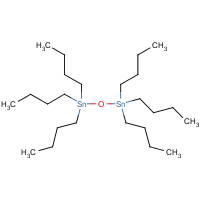Bis(tri-n-butyltin)oxide
Agent Name
Bis(tri-n-butyltin)oxide
Alternative Name
TBTO
CAS Number
56-35-9
Formula
C24-H54-O-Sn2
Major Category
Metals

Synonyms
TBTO; 6-Oxa-5,7-distannaundecane, 5,5,7,7-tetrabutyl-; BioMeT SRM; Biomet; Biomet 66; Biomet TBTO; Bis(tri-n-butylzinn)-oxyd [German]; Bis(tributyloxide) of tin; Bis(tributylstannium) oxide; Bis(tributylstannyl)oxide; Bis(tributyltin) oxide; Bis(tributyltin)oxide; Bis-(tri-n-butylcin)oxid [Czech]; Butinox; C-Sn-9; Hexabutyl distannoxane; Hexabutyldistannioxan [Czech]; Hexabutyldistannoxane; Hexabutylditin; Kyslicnik tri-n-butylcinicity [Czech]; L.S. 3394; Lastanox F; Lastanox Q; Lastanox T; Lastanox T 20; Mykolastanox F; OTBE [French]; Oxybis(tributylstannane); Oxybis(tributyltin); Oxyde de tributyletain; Stannane, tri-n-butyl-, oxide; Stannicide A; Tin, bis(tributyl)-, oxide; Tin, oxybis(tributyl-; Tributyltin oxide; Vikol AF-25; Vikol LO-25; ZK 21995; Distannoxane, 1,1,1,3,3,3-hexabutyl-; Distannoxane, hexabutyl-; [ChemIDplus] Tributyl tin oxide; [Malo] UN3020
Category
Tin Compounds, Organic
Description
Yellow liquid; [HSDB]
Sources/Uses
Used as antimicrobial and slimicide for cooling-water treatment, disinfectant for hard-surface, sanitizer for laundry, mildewcides in water-based emulsion paints, preservative for timber, millwork, wood, textiles, paper, leather, and glass, and as fungicide and bactericide in underwater and antifouling paints; Also used as pesticide, molluscicide, rodent repellant, and insecticide; [HSDB] Used as a bactericide, fungicide, and chemical intermediate; [CAMEO] Used as fungicide, disinfectant, algicide, microbiocide, and microbiostat for cooling tower water, wood preservation (paints, stains, and waterproofing formulations), hard surfaces (livestock, veterinary, and other animal facilities), building materials (drywall, joint compound MDF board, and particulate board), building material adhesives, and adhesives for other manufacturing applications; Also used to treat textile fabrics (except laundry and clothing), paper, fiberfill, foam, rope, sponges, and other materials;
Tributyltin products are also used in petrochemical injection fluids, metal working fluids, irrigation tubing for non-agricultural uses, rubber for sonar domes, and instruments for oceanographic observations; [EPA RED]
Comments
Classified as "moderately toxic," some formulations are for "Restricted Use." [EXTOXNET] Occupational asthma reported in venipuncture technician (phlebotomist) using needles treated with bis(tri-n-butyltin)oxide; [Malo] Tributyltin oxide is a strong skin irritant. [Kanerva, p. 1841] Skin contact may cause redness and delayed burns; Inhalation of aerosol may cause pneumonitis and pulmonary edema; [ICSC] Low acute toxicity by skin absorption with an LD50 of >9000 mg/kg for the rabbit; Causes heptocellular necrosis in rats fed 25 mg/kg for 4 weeks; Causes adverse effects to the thymus, impairing cell mediated immunity at doses as low as 5 mg/kg in rats; No convincing evidence that TBTO is mutagenic; No teratogenic effects at doses below those that cause maternal toxicity; Tumors have been seen in animal studies, but their significance is questionable; [Reference #1] Skin, eye, and respiratory tract irritation, dermatitis, headache, nausea, and vomiting have been reported in occupationally exposed individuals; [HSDB] See "Tin, organic compounds."
Restricted
Tributyltin compounds are regulated by the EPA under the Organotin Antifouling Paint Control Act of 1988; Registration cancelled in 2005 for tributyltin ship hull coatings; International ban effective as of September 2008; [Reference #2]
Reference Link #1
Biomedical References
Exposure Assessment
Skin Designation (ACGIH)
Yes
TLV (ACGIH)
0.1 mg/m3, as Sn
STEL (ACGIH)
0.2 mg/m3, as Sn
PEL (OSHA)
0.1 mg/m3, as Sn
MAK
0.02 mg/m3, inhalable fraction, as Sn
IDLH (NIOSH)
25 mg/m3, as Sn
Vapor Pressure
7.5E-06 mm Hg
Lethal Concentration
LCLo (guinea pig) = 200 mg/m3
Explanatory Notes
bp = 180 deg C at 2 mmHg; [HSDB] Organic tin compounds have a "skin" designation and are classified as "A4" (Not classifiable as human carcinogen); [ACGIH] ERG for "Organotin pesticide, liquid, toxic.”
Reference Link #2
Adverse Effects
Asthma
Yes
Toxic Pneumonitis
Yes
Neurotoxin
Other CNS neurotoxin
Hepatotoxin
Hepatoxic (a) from occupational exposure (secondary effect) or (b) in animal studies or in humans after ingestion
Dermatotoxin
Skin burns
ACGIH Carcinogen
Not Classifiable
Diseases, Processes, and Activities Linked to This Agent
Diseases
Occupational diseases associated with exposure to this agent:
Processes
Industrial Processes with risk of exposure: